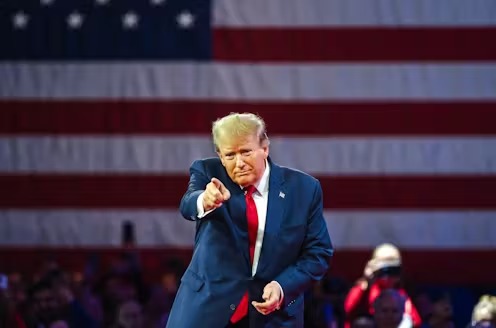Following Donald Trump’s victory in the US presidential elections, Europe now has to prepare for a new era of economic protectionism. Trump’s policies during a second term will undoubtedly have major consequences for the continent’s economy, geopolitical stability and progress addressing climate change, and may even threaten the future of globalisation itself.
The stakes are high for Europe. Beyond decades of political and cultural cooperation, the European Union and US have the largest bilateral trade and investment relationship in the world, which, at its peak in 2021, reached €1.2 trillion.
Tariffs, China and collateral damage
The most immediate economic worry for Europe will be tariffs. Trump has floated the idea of replacing the federal income tax with across-the-board tariffs ranging from 10% to 20%. Higher tariffs will affect Europe both directly and indirectly.
The direct impact will be higher tariffs on European exports in all categories, from steel and vehicles to cheese and wine, with the aim of making them less competitive in US markets.
Even if tariffs aren’t directly aimed at European goods, European companies could still suffer if the US decides to apply sanctions on products using Chinese parts or technology, or pressures Europe to decouple from China.
The European economy is profoundly integrated into global value chains, and China is its second-largest trading partner for goods after the US – bilateral trade between the EU and China reached €739 billion in 2023.
Europe’s largest imports from China are telecommunications equipment, electrical machinery and apparatus, and automatic data-processing machines. Its main exports are cars and vehicles, medicines and other machinery. These are all key sectors, and if they are blocked or cut off it will deeply harm Europe’s economy. US efforts to slow China’s perceived economic and technological advance may therefore inflict collateral damage on Europe.
Speaking at the IESE Madrid campus in June, Nobel laureate Joseph Stiglitz noted that it is difficult for Europeans to comprehend the deep-seated, bipartisan “paranoia” that the US feels towards China. In his words, “it’s a very big part of US thinking because it’s both parties, and it’s focused a lot on economics.”
Geopolitics and defence spending
While Biden’s foreign policy was defined by his Secretary of State Anthony Blinken as “values-based diplomacy”, Trump will probably reappoint Michael Pompeo, or another Republican with a similar profile who will put their understanding of US interests front and centre.
For Europe, this will likely mean a drastic reduction in US support for the government of Ukraine, as well as renewed pressure on the North Atlantic Treaty Organization (NATO) – the US still funds just under 70% of NATO’s budget.
This process will, of course, take some time, but it will force European countries to make choices about defence. One option will be to sharply increase spending for both Ukraine and NATO, which will impact already strained budgets across the continent.
The United Kingdom and northern EU countries will likely support the path of higher defence spending in order to keep Russian ambitions in check, but other EU countries, such as Hungary, are unlikely to back sharp increases.
Without strong support from Europe, Ukraine may have no choice but to negotiate some kind of ceasefire or accord that effectively cedes Crimea and some of its eastern provinces to Russia. The risk is that, over the medium and long term, Russia may see a partial victory in Ukraine as a green light for continued expansion in Moldova, and perhaps the Baltic states.
Questions around inflation and climate change
Another big economic question for Europe will be the future of the Biden administration’s 2022 Inflation Reduction Act (IRA), the largest environmental legislation in US history. For many European governments the IRA clearly violates global trade rules of the World Trade Organization, and provides incentives for investments that otherwise would have gone to Europe.
While Trump has said he opposes the IRA and does not believe in climate change, many of the IRA subsidies have gone to Republican-controlled states and will be hard to disentangle. At the same time, Trump has made it clear that he will give free rein to fossil-fuel development and once again pull the United States out of the Paris climate accord.
US wavering on environmental issues will strengthen opposition to Europe’s transition to a low-carbon economy. It is possible that Europe’s pursuit of energy independence and the will of the European populace will be sufficient to keep the momentum up, but critics of green policies will be emboldened, especially on matters of cost.
Future of globalisation at stake
Perhaps the biggest danger of a Trump administration is the future of globalisation itself. As the latest meeting of the BRICS nations in Kazan, Russia made it clear that a number of countries around the world are looking to change the very structure of the international order that the world has enjoyed over the last 60 years or so.
It will take more than just four years of protectionist policies in the United States to undo global supply chains and long-standing trade patterns. However, this second Trump administration may mark a turning point, and he may be succeeded by another Republican who continues on the same path.
Given time, we may see an end to globalisation as we know it, and the emergence of two or three trading blocs around the world which are fenced off from each other by high tariffs, geopolitical tensions, and different political systems and philosophies.



 Robinhood Expands Sports Event Contracts With Player Performance Wagers
Robinhood Expands Sports Event Contracts With Player Performance Wagers  ETH Bulls Smash Trendline – $4,000 Next as Whale Squeeze Tightens
ETH Bulls Smash Trendline – $4,000 Next as Whale Squeeze Tightens  Asian Stocks Slide as AI Valuation Fears and BOJ Uncertainty Weigh on Markets
Asian Stocks Slide as AI Valuation Fears and BOJ Uncertainty Weigh on Markets  Wall Street Futures Slip as Tech Stocks Struggle Ahead of Key US Economic Data
Wall Street Futures Slip as Tech Stocks Struggle Ahead of Key US Economic Data  Evercore Reaffirms Alphabet’s Search Dominance as AI Competition Intensifies
Evercore Reaffirms Alphabet’s Search Dominance as AI Competition Intensifies  China’s November Economic Data Signals Slowing Industrial Output and Weak Consumer Demand
China’s November Economic Data Signals Slowing Industrial Output and Weak Consumer Demand  Gold and Silver Prices Dip as Markets Await Key U.S. Economic Data
Gold and Silver Prices Dip as Markets Await Key U.S. Economic Data  Asian Currencies Trade Sideways as Dollar Weakens Ahead of Key U.S. Data
Asian Currencies Trade Sideways as Dollar Weakens Ahead of Key U.S. Data  Asian Technology and Chipmaking Stocks Slide as AI Spending Concerns Shake Markets
Asian Technology and Chipmaking Stocks Slide as AI Spending Concerns Shake Markets  Silver Prices Hit Record High as Safe-Haven Demand Surges Amid U.S. Economic Uncertainty
Silver Prices Hit Record High as Safe-Haven Demand Surges Amid U.S. Economic Uncertainty  Korea Zinc to Build $7.4 Billion Critical Minerals Refinery in Tennessee With U.S. Government Backing
Korea Zinc to Build $7.4 Billion Critical Minerals Refinery in Tennessee With U.S. Government Backing 































